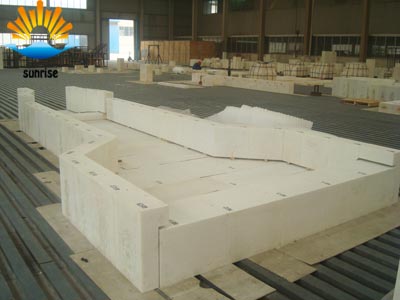 BackNews
BackNews
How Much do You Know About the Raw Materials and Ingredients of Cast-cast Corundum Bricks?
2019-08-28 16:52:53The raw materials for the cast-cast corundum bricks are mainly alumina and quartz sand. The compound of the cast-cast corundum brick was mixed by industrial alumina 97% and quartz sand 3% on a wheel mill for 40 min.
Adding different materials according to the product requirements, such as manufacturing α-Al2O3 bricks, adding a small amount of co-solvent, such as the introduction of boron oxide, can accelerate the melting process and increase the melt viscosity. Because the viscosity of industrial alumina melt is very low, the crystallization ability is very strong, and the melt is too late to eliminate harmful gas impurities, so that a large number of micropores are formed in the casting, so it is necessary to increase the viscosity of the melt.
A relatively simple alumina cast brick can be melted directly with a powdered ingredient. But there are some disadvantages as follows:
a. Dust will fly during the feeding and melting process, causing both loss and environmental impact;
b. The density of the components in the ingredients is different and easy to stratify, so that the composition and structure in the casting are not uniform;
c. The density of the powder is small, and the efficiency of the conveying and storage tools is low;
d. The powder has low conductivity and increases the energy consumption for melting.

Melting with a granular material has the following advantages:
a. no flying loss during conveying and feeding;
b. The electric furnace can be filled with full capacity, and the melting process can be stabilized, the melt composition is accurate, and the production capacity is improved;
c. Granular materials create conditions for mechanization of feedstock.
In the preparation process of raw materials for cast-cast corundum brick, the granulation of the raw material is to grind the mixture to the required fineness in a ball mill, and then to the disc granulator for granulation: during the granulation process, the fine powder particles gradually roll. It is thick and firm, and the particles are uniformly spherical, with a diameter of about 12 mm, and then calcined at 800 to 900 ° C to make it have the strength required for mechanized transportation. In addition, the pellets can also be obtained by using a briquetting, calcination and crushing method.
The bauxite or its sinter can also be used to fused corundum. Generally, corundum with abrasives containing 93% to 96.5% of Al2O3 can be obtained, and fused alumina with Al2O3 93%~96% can be electrofused with kaolinite.

